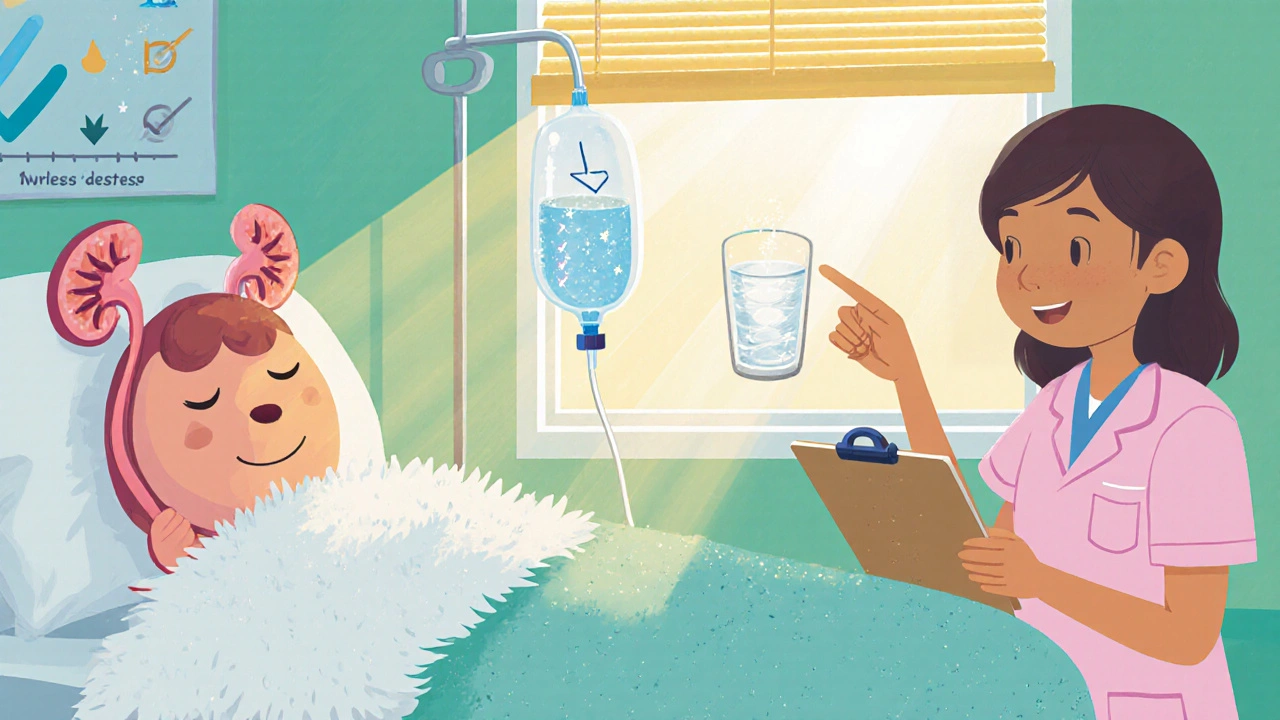Aminoglycoside Dosing Calculator
Patient Information
Results
Imagine fighting a life‑threatening infection only to end up with a hurting kidney. That paradox is the reality for many patients who receive Aminoglycoside antibiotics - a powerful class of drugs that can turn into a renal nightmare if we’re not careful.
What are aminoglycoside antibiotics?
These drugs, including Gentamicin, Tobramycin and Amikacin, are bactericidal agents that attack the protein‑making machinery of Gram‑negative bacteria. First introduced in the 1960s, they remain the go‑to option for multidrug‑resistant infections such as Pseudomonas aeruginosa, Acinetobacter spp., and certain Enterobacteriaceae.
Why do they hurt the kidneys?
The kidney damage, known as Nephrotoxicity, is dose‑dependent and starts when about 5 % of the administered drug stays stuck inside the epithelial cells of the S1 and S2 segments of the Proximal tubule. Once inside, the drug pools in endosomal and lysosomal vacuoles, then drifts to the Golgi complex, sparking a cascade: lysosomal swelling, phospholipid buildup, mitochondrial collapse, and finally cell death.
Electron‑microscopy studies show enlarged lysosomes filled with myeloid bodies within a few days of exposure. As the injury spreads, tubular obstruction, tubuloglomerular feedback, and renal vasoconstriction all chip in, cutting the glomerular filtration rate (GFR) even before the tubules are visibly damaged.
How does the damage look in the lab?
The classic picture is a non‑oliguric rise in Serum creatinine (≥0.5 mg/dL or a 50 % jump above baseline) after 5-7 days of continuous therapy. Urine output stays above 400 mL/day, which can mislead clinicians into thinking the kidneys are still fine.
Early biomarkers leap before creatinine rises: urinary beta‑2‑microglobulin, alpha‑2‑macroglobulin, lysozyme, alanylaminopeptidase and N‑acetyl‑β‑glucosaminidase all surge. Electrolyte wasting (Na⁺, K⁺, Mg²⁺, Ca²⁺) and proteinuria are also common clues.
Who is most at risk?
- Pre‑existing chronic kidney disease (eGFR < 60 mL/min/1.73 m²) - risk ↑ 3.2‑fold.
- Age > 65 years - renal reserve drops sharply.
- Concomitant nephrotoxins (e.g., Vancomycin) - adds a 2.7‑fold risk.
- Volume depletion or aggressive diuresis.
- Treatment longer than 7 days.
Across hospital settings, about 10‑25 % of patients on aminoglycosides develop acute kidney injury (AKI), accounting for roughly 15 % of all antibiotic‑related AKI cases.

Dosing schedules: once‑daily vs multiple‑daily
Research consistently points to dosing frequency as a major lever for safety. A 2003 pharmacodynamic model showed that, for the same total daily dose, thrice‑daily regimens produced faster GFR decline, deeper creatinine spikes, and slower recovery than a single once‑daily dose. Even the time of day matters - giving the dose around 1:30 p.m. appears to hit the kidney’s “low‑vulnerability” window.
| Regimen | Mean daily dose (mg/kg) | Incidence of AKI | Average time to creatinine rise (days) |
|---|---|---|---|
| Once‑daily (single dose) | 5-7 | 9 % | 7 |
| Twice‑daily | 2.5-3.5 each | 14 % | 5 |
| Thrice‑daily | 1.7-2.3 each | 21 % | 4 |
These numbers reinforce the now‑standard guideline: use the highest safe once‑daily dose whenever the pathogen’s MIC allows it.
Practical prevention and management
Because the drug’s usefulness can’t be tossed aside for many resistant infections, clinicians focus on three pillars: dose optimization, vigilant monitoring, and protecting the tubules.
- Dose optimization: Aim for once‑daily dosing, keep trough levels < 1 µg/mL for gentamicin, and adjust for weight and renal function using the Cockcroft‑Gault equation.
- Therapeutic drug monitoring (TDM): Check peak serum concentrations 30 minutes after infusion, then repeat every 48-72 hours. Rising creatinine should prompt immediate re‑assessment.
- Nephroprotective strategies: While no drug is FDA‑approved yet, experimental work with Polyaspartic acid shows promise. In animal models it blocks aminoglycoside binding to phospholipid membranes, curbing phospholipidosis and preserving lysosomal function. Human trials (Phase II, NCT04567821) are in progress.
Other bedside tricks include aggressive hydration (1 L IV normal saline before and after the dose) and avoiding concurrent NSAIDs or contrast media.
Recovery expectations
When the drug is stopped, creatinine usually starts to fall within 3-5 days. Full functional recovery takes 1-3 weeks for most patients, but about 15 % end up with a permanent GFR reduction. A 2021 Mayo Clinic cohort (n = 1,247) reported 82 % partial or complete recovery within 30 days, underscoring that early detection truly matters.

Where the research is headed
Two big themes dominate the pipeline:
- Mitochondrial protection: New antioxidants targeting reactive oxygen species in proximal tubule cells are in pre‑clinical testing. Early data suggest they blunt the apoptosis cascade triggered by aminoglycoside‑induced ROS.
- Less‑toxic derivatives: Chemists are tweaking the aminoglycoside scaffold to retain antibacterial potency while reducing renal uptake. One candidate, “plazomicin‑like” molecule, shows 40 % lower kidney accumulation in rat studies.
Funding from the National Institute of Diabetes and Digestive and Kidney Diseases (NIDDK) has risen to $24.7 M for 2021‑2023 projects, reflecting the high clinical burden (an estimated 12.5 million courses worldwide in 2022).
Quick checklist for clinicians
- Confirm indication - reserve aminoglycosides for MDR Gram‑negative infections.
- Calculate dose based on actual body weight and current eGFR.
- Prefer once‑daily administration; if not possible, keep intervals >8 h.
- Obtain baseline serum creatinine and electrolytes.
- Monitor peak/trough levels; repeat serum creatinine every 48-72 h.
- Hydrate aggressively before and after each dose.
- Discontinue at the first sign of ≥0.5 mg/dL creatinine rise or significant electrolyte loss.
- Consider enrolling eligible patients in polyaspartic‑acid or mitochondrial‑protectant trials.
Following this list can shave the nephrotoxicity rate from the historical 20 % down into the single digits.
Bottom line
aminoglycoside nephrotoxicity is a predictable, dose‑related injury that can be tamed with smarter dosing, strict monitoring, and emerging protectants. The drugs remain lifesavers, but only when we respect their narrow therapeutic window.
What signs indicate early kidney injury from aminoglycosides?
Early clues include rising urinary beta‑2‑microglobulin, alkaline phosphatase, and a sudden increase in urinary sodium or potassium loss. Serum creatinine usually lags by 48-72 hours.
Is once‑daily dosing safe for all patients?
It’s safe for most adults with normal renal function. In patients with severe renal impairment, dose reduction and extended intervals are still required, and TDM becomes critical.
Can polyaspartic acid be used right now?
Not yet. It’s in Phase II trials; clinicians can only enroll patients in those studies or use it under investigational protocols.
How long should I monitor kidney function after stopping the drug?
Continue daily serum creatinine checks for at least 7 days, then every other day until it returns to baseline or stabilizes.
Are there any alternatives to aminoglycosides for MDR Gram‑negative infections?
Colistin, tigecycline, and newer β‑lactam/β‑lactamase inhibitor combos are options, but each carries its own toxicity profile and resistance concerns. Choice depends on the isolate’s susceptibility.

Aminoglycosides: ruthless bug‑killers, merciless kidney‑slicers
Listen up, folks! The science is crystal‑clear: once‑daily dosing slashes kidney injury by half, while thrice‑daily regimens shove you straight into renal failure. The data from the 2003 pharmacodynamic model isn’t a suggestion-it’s a mandate. If you dare ignore the “low‑vulnerability” window at 1:30 p.m., you’re practically signing a death warrant for the proximal tubules. So stop dabbling in outdated multiple‑dose schedules and give the kidneys a fighting chance.
Bro, in India we still see docs using old‑school 3×‑daily regimens, and the AKI rates skyrocket. You cant just ignore the weight‑based dosing charts – kidney health depends on it. The litreature says once‑daily is the gold standard, but many hospitals cling to tradition like it’s a religion. Wake up, update the protocols, or watch more patients end up on dialysis.
The pharma elites hide the once‑daily data to keep us buying expensive combo‑drugs.
When we examine the balance between lifesaving antibiotics and the sanctity of renal function, we confront an ethical crossroads. The kidneys, often taken for granted, serve as the body’s natural filtration system, and their compromise reverberates beyond labs. It is not merely a biochemical event but a reminder of our responsibility to wield potent medicines with humility. Thoughtful dosing, vigilant monitoring, and patient education form a triad of stewardship. Hydration, avoidance of nephrotoxic co‑agents, and timely cessation at early creatinine rise are practical pillars. By integrating these steps, we honor both the urgency of infection control and the long‑term health of our patients. Let us therefore adopt the evidence‑based once‑daily protocol not as a suggestion, but as a moral imperative.
Nice essay, Grace 😏. But in the real world, doctors who ignore the guidelines are the ones we need to call out. If you’re not dosing once‑daily, you’re practically inviting AKI. 🙄
For clinicians looking to minimize aminoglycoside nephrotoxicity, start with a precise eGFR‑based dose calculation using the Cockcroft‑Gault formula. Target a peak of 5‑10 µg/mL for gentamicin and keep troughs below 1 µg/mL. Implement aggressive hydration-1 L isotonic saline before and after the infusion-to dilute renal tubular concentrations. Schedule serum creatinine and electrolyte checks every 48 hours, and act at the first sign of a 0.5 mg/dL rise. If possible, opt for therapeutic drug monitoring every 72 hours to adjust dosing in real time. Finally, consider enrolling eligible patients in ongoing polyaspartic‑acid trials for potential renal protection.
Buddy you think the labs are clean but the hidden agencies are tweaking the creatinine numbers. The pharma cvs are in on it, making us chase the wrong biomarkers. Keep an eye on the secret data leaks, they dont want you to know the real safe dosing window.
The pharmacokinetic profile of aminoglycosides dictates a narrow therapeutic index, necessitating rigorous dose individualization. Empirical evidence demonstrates a statistically significant reduction in AKI incidence when employing a single, high‑dose regimen. Moreover, the temporal correlation between drug administration and renal vasoconstriction underscores the importance of timing. Accordingly, clinicians should prioritize once‑daily dosing, supported by systematic therapeutic drug monitoring.
Ah, the lofty prose of Dr. Witcher-truly a beacon of clinical enlightenment.
One can hardly imagine a world where dosing decisions are anything less than an art form worthy of a sonnet.
Your insistence on “statistically significant reduction” feels less like science and more like a prayer whispered to an indifferent universe.
It’s adorable how you champion once‑daily regimens as if they were the holy grail of nephrology.
Meanwhile, the real‑world clinicians are left juggling fluid balances, TDM logistics, and the occasional bureaucratic nightmare.
Do you also expect them to conjure up a crystal ball to foresee every pharmacodynamic nuance?
The literature you cite may well be impeccable, yet it neglects the messy reality of resource‑constrained settings.
Not every hospital has a 24‑hour lab capable of delivering timely peak‑trough levels.
And let’s not forget the patients whose comorbidities render any simplistic dosing algorithm barely adequate.
Your emphasis on “rigorous dose individualization” would be refreshing if it didn’t feel like a passive‑aggressive jab at anyone not already in the academic elite.
Sure, we can schedule creatinine checks every 48 hours, but what about the nurses already buried under paperwork?
Perhaps a dose of humility would complement your suggested therapeutic drug monitoring.
In an ideal universe, each prescriber would have a personal pharmacist on standby, ready to adjust doses at the snap of a finger.
Alas, the real world prefers cost‑effectiveness over poetic dosing regimens.
So, while your prose dazzles the ivory‑tower crowd, the bedside clinician simply sighs and administers the best they can.